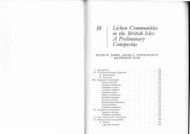You also want an ePaper? Increase the reach of your titles
YUMPU automatically turns print PDFs into web optimized ePapers that Google loves.
Key to the Determination <strong>of</strong> Lichen Genera and Algae<br />
1 Organization and Use <strong>of</strong> the Key<br />
The general key makes possible the<br />
determination <strong>of</strong> the most important commonly<br />
distinguished lichen groups according to the<br />
growth form <strong>of</strong> the thallus or the form <strong>of</strong> the<br />
fruiting body. In a second step following after<br />
the lichen group, genus keys leads to the lichen<br />
genus. The species keys are likewise brought<br />
under the corresponding genera, where they are<br />
treated in alphabetical order.<br />
In front <strong>of</strong> the general key for the<br />
determination <strong>of</strong> the lichens is concise key for<br />
the determination <strong>of</strong> the most important algae<br />
occurring in lichens.<br />
The keys are alternative keys. Normally at any<br />
given time two contrasting possible choices are<br />
presented, <strong>of</strong> which one is correct for the species<br />
being keyed, the other is not. The two matching<br />
choice possibilities are designated with the same<br />
numeral. The correct alternative leads either<br />
directly or indirectly, by further alternative pairs,<br />
to the name <strong>of</strong> the species.<br />
Example: Determining a brown foliose lichen<br />
with a light underside:<br />
1 Thallus yellow 2<br />
1* Thallus brown 4<br />
2 Thallus with fruiting bodies Lichen A<br />
2* Thallus without fruiting bodies 3<br />
3 Thallus on bark Lichen B<br />
3* Thallus on rock Lichen C<br />
4 Lichen underside black . 5<br />
4* Lichen underside whitish Lichen D<br />
5 etc.<br />
The alternative 1/1* with the possible choice<br />
“Thallus brown” leading to 4. here leads to the<br />
fitting possible choice “Thallus underside<br />
whitish” to no further alternative, but directly to<br />
the name <strong>of</strong> the species keyed (Lichen D). A<br />
yellow lichen with fruiting bodies would key out<br />
by alternative 2 to (Lichen A).<br />
The keys are arranged so that the decisive<br />
differentiating characters are at the beginning, so<br />
that <strong>of</strong>ten a “rapid keying” is possible, that above<br />
all dispenses with the consideration <strong>of</strong> other<br />
mentioned characters. At the next place are <strong>of</strong>ten<br />
characteristic attributes, which will not be used<br />
under any circumstances in accordance with the<br />
contrast in the case <strong>of</strong> the alternative.<br />
The goal <strong>of</strong> the genus key is not the keying <strong>of</strong><br />
the entire genus. These keys frequently lead in<br />
the interest <strong>of</strong> easier keying to groups <strong>of</strong> genera<br />
(“GS”= group key), where differentiation<br />
according to taxonomically relevant characters<br />
avoids many unnecessary problems, because the<br />
keying out <strong>of</strong> the similar <strong>of</strong>ten presents no<br />
difficulties.<br />
In the determination keys are given in the<br />
case <strong>of</strong> keyed species at times also the lichen<br />
substances, as a rule however only so far as they<br />
may be determined with the help <strong>of</strong> thin layer<br />
chromatography and are significant. Abundant<br />
side by side lichen substances are as a rule not<br />
known (e.g. Lecanoric acid is side by side with<br />
Gyrophoric acid); accordingly known sometimes<br />
as the lichen substance syndrome, with which is<br />
designated a group <strong>of</strong> biosynthetic related<br />
substances. If the name <strong>of</strong> the lichen substance is<br />
in parentheses, it occurs only in low<br />
concentration (and is then <strong>of</strong>ten difficult to<br />
demonstrate with TLC), if before the name is<br />
placed “±”, then the material may also be<br />
lacking.<br />
The reference to an illustration (symbol )<br />
helps verify the keying result at hand by<br />
examining the photograph. Considering the large<br />
variability <strong>of</strong> many species one must<br />
notwithstanding from time to time choose<br />
between considerable habitual differences <strong>of</strong> that<br />
to be determined and the illustrated example. In<br />
the genus keys only judicious illustrations are put<br />
forward, when a large part <strong>of</strong> the species in<br />
question are illustrated and consequently<br />
essential habitual attributes <strong>of</strong> the genus are<br />
rendered. “↑” attached to the species name<br />
means that species in the corresponding genus<br />
were described earlier. A number in parentheses<br />
“(18)” behind the species name means that the<br />
species in the same key, keys out at another place<br />
(here at alternative 18). Author names behind a<br />
species name lets us know that the species<br />
concerned in the main part (in the case <strong>of</strong> the<br />
genus) will not be further considered. “!” after<br />
the alternative number means that still another<br />
possible choice is given. See topic 7 for<br />
additional symbols and abbreviations.<br />
2 Key to the Lichen Algae<br />
Presented are only genera and groups the<br />
knowledge <strong>of</strong> which is necessary or helpful for<br />
the keying <strong>of</strong> lichens in the following genus keys.<br />
Most <strong>of</strong> the algae treated are recognized without<br />
great difficulty. Squash preparations and<br />
sections through the lichen thallus are enough for<br />
identification. A thorough going determination<br />
becomes problematic, since the algae in the<br />
34





